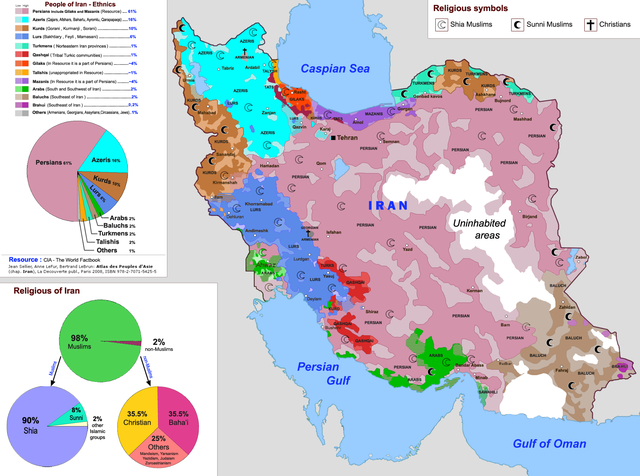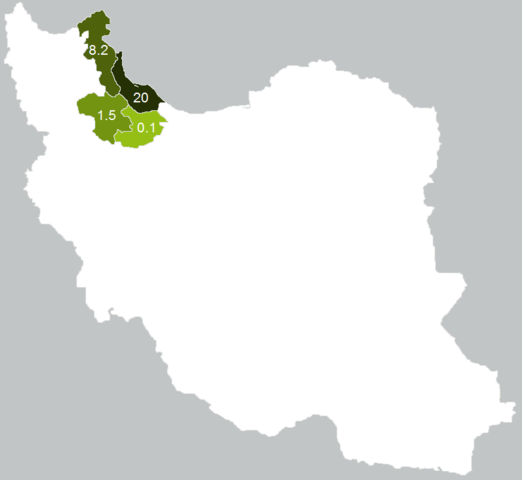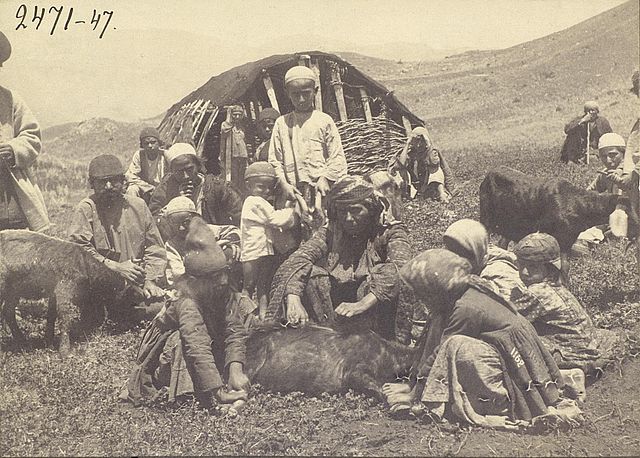
| TALYSH
Talysh women in Azerbaijan Languages
: Talysh, Azerbaijani, Gilaki, Persian, Russian
Talysh (also Talishi, Taleshi or Talyshi) are an Iranian ethnic group indigenous to a region shared between Azerbaijan and Iran which spans the South Caucasus and the southwestern shore of the Caspian Sea. They speak the Talysh language, one of the Northwestern Iranian languages. It is spoken in the northern regions of the Iranian provinces of Gilan and Ardabil and the southern parts of the Republic of Azerbaijan. Northern Talysh (the part in the Republic of Azerbaijan) was historically known as Talish-i Gushtasbi. In Iran there is a Talesh County in Gilan Province.
Origins
:
Language
:
Genetics
:
Location :
Talysh in Iran
Percent of Talysh people in provinces of Iran, 2011 There are no statistical data on the numbers of Talysh-speakers in Iran, but estimates show their number to be around 1 million. [citation needed] Talysh nationalists claim that the number of Talysh in Azerbaijan is around 835,000. The number of Talysh speakers in 2003 was estimated to be at least 400,000 in the Republic of Azerbaijan. According to the official 1999 census of the Republic of Azerbaijan, whose figures are in dispute by Talysh nationalists, the number of Talysh people in the Republic of Azerbaijan was 76,000. According to some sources, the Azerbaijani government has also implemented a policy of forceful integration of all minorities, including Talysh, Tat, and Lezgins. However, in a view of Hema Kotecha "the attitude towards any separatist tendencies seems predominantly negative" among the Talysh. According to Swedish scholar on Eurasia Svante E. Cornell :
Whereas officially the number of Lezgins registered as such is around 180,000, the Lezgins claim that the number of Lezgins registered as Azerbaijani is many times higher than this figure, some accounts showing over 700,000 Lezgins in Azerbaijan. These figures are denied by the Azerbaijani government but in private many Azeris acknowledge the fact that Lezgins – for that matter Talysh or the Tat population of Azerbaijan is far higher than the official figure. The unofficial census of the Netherlands is 1.
Demographics :
Talysh language dialects According to the Russian Imperial Census of 1897 there were 34,994 Talysh in Baku Governorate.
According to a 1926 census, there were 77,039 Talysh in Azerbaijan SSR. From 1959 to 1989, the Talysh were not included as a separate ethnic group in any census, but rather they were included as part of the Turkic-speaking Azerbaijanis, although the Talysh speak an Iranian language. In 1999, the Azerbaijani government claimed there were only 76,800 Talysh in Azerbaijan, but this is believed to be an under-representation given the problems with registering as a Talysh. Some claim that the population of the Talysh inhabiting the southern regions of Azerbaijan is 600,000. Talysh nationalists have always asserted that the number of Talysh in Azerbaijan is substantially higher than the official statistics.
Obtaining accurate statistics is difficult, due to the unavailability of reliable sources, intermarriage, and the decline of the Talysh language. and Radio Free Europe/Radio Liberty have voiced their concerns about the arrest of Novruzali Mamedov, Chairman of the Talysh Cultural Centre and editor-in-chief of the Tolyshi Sado newspaper.
According to a U.S. government interview with Khilal Mamedov, a Talysh rights activist, Mr. Mamedov: “Accused the Azerbaijani leadership of Turkic nationalism and of seeking to suppress non-Turkic minorities…. He said the Azerbaijani leadership seeks to minimize contacts between the Talysh communities in Azerbaijan and Iran and to run Azerbaijan into a monoethnic state.”
Culture
and religion :
During
modern history :
Talysh people in Iran, 1933 According to Russian historian and ethnologist Victor Schnirelmann :
Simultaneously ethnic minorities suffered persecutions in Azerbaijan. After Soviet power was established, the Iranian speaking Talyshes, who lived in southeast Azerbaijan dreamt of the restoration of the Talysh Mugan republic declared in the summer of 1919 and brutually ruined by Ottoman Troops. In 1936–38, Talysh nationalists were exiled to Siberia, and Talysh schools were closed. Broadcasting in Talysh was abolished, and the Talyshes were deprived of their mass media in general. Since that time, the Talyshes have been pressed to identify themselves with the Azeris.
From
1991 to present :
As of 2008, Ismail Shabanov was the president of the Talysh diaspora of Russia.
The
National Talysh Movement (NTM) :
Source :
https://en.wikipedia.org/ |




